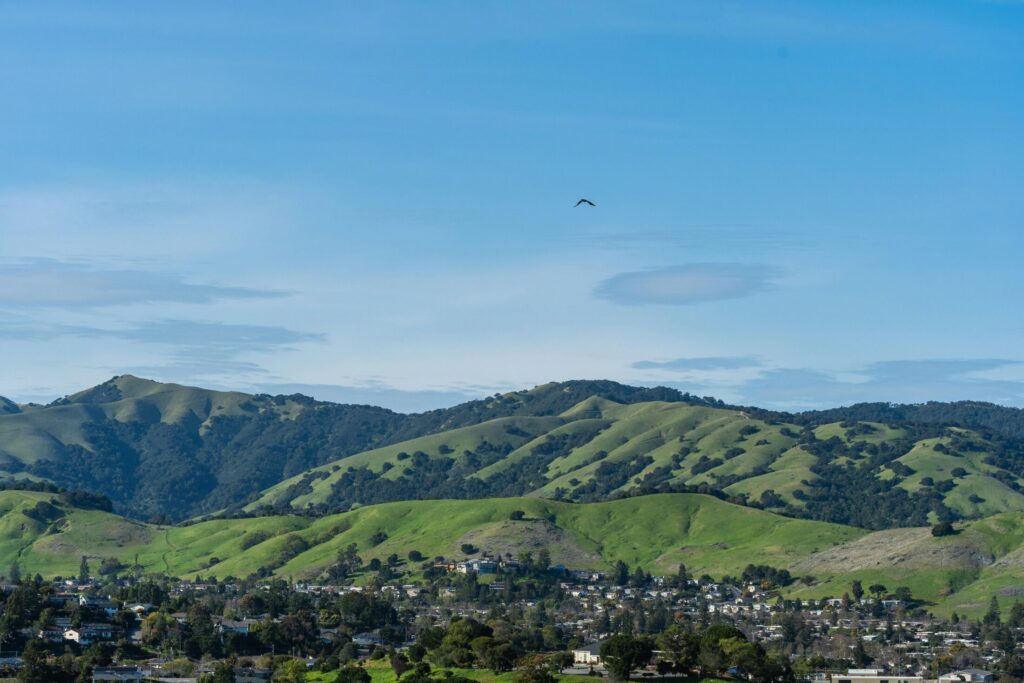Moving to Fremont, California, is a smart choice for anyone seeking a balance of career opportunity, community, and quality of life.
Nestled between Silicon Valley and the East Bay, Fremont offers access to world-class employers like Tesla and Lam Research, top-rated public schools, safe neighborhoods, and an incredibly diverse, welcoming population.
Though the cost of living is high, it’s matched by high incomes, excellent schools, and a vibrant cultural scene—making Fremont one of the Bay Area’s most rewarding places to put down roots.
Before moving to Fremont, it’s worth taking a closer look at what everyday living here truly costs—and why so many people still decide that moving to Fremont is a smart investment in both lifestyle and opportunity.

1. The Cost of Living Reality Check
Let’s start with the bottom line: Fremont isn’t cheap. In fact, its overall cost of living runs about 87% to 95% higher than the U.S. average, depending on housing fluctuations and inflation trends.
This East Bay gem sits squarely in one of the most competitive markets in the country — and the numbers reflect that.
Housing is by far the biggest contributor to Fremont’s high cost of living. Median home prices now exceed $1.3 million, making it one of the priciest suburban markets outside San Francisco.
Renters aren’t spared either — a two-bedroom apartment averages around $3,000 per month, often with multiple applications vying for the same unit.
Groceries, utilities, and transportation also trend higher — typically 15% to 45% above national averages. Whether it’s your PG&E bill, a gallon of gas, or a night out, the Bay Area price tag shows up in nearly every line item of your budget.
Here’s the good news: Fremont residents earn some of the highest household incomes in the nation. Median household income hovers between $144,000 and $170,000, thanks in large part to tech and engineering professionals.
That income cushion helps many families handle the cost of living without feeling stretched too thin — but financial discipline remains key.
2. Housing: Ownership vs. Renting
The Fremont housing market is a study in contrasts. Homeownership rates are high — around 62% of residents own their homes, compared to the California average of roughly 55%.
Buyers tend to stay put for the long haul, driven by the city’s stability, schools, and job proximity.
The median home sale price is roughly $1.35 million as of late 2025, though prices vary by neighborhood. Entry-level single-family homes start around $1 million, while luxury estates in Mission San Jose can easily reach $2.5 million or more.
Renters, on the other hand, face fierce competition. Apartments and single-family rentals move quickly, often requiring strong credit, proof of income, and a hefty security deposit.
Many renters use Fremont as a stepping stone — saving for a down payment while working in nearby Silicon Valley.

3. Fremont’s Top Neighborhoods and Vibe
Fremont is a city of distinct neighborhoods, each with its own character, rhythm, and appeal.
Mission San Jose
Mission San Jose is Fremont’s crown jewel. Known for elite schools and multimillion-dollar properties, it attracts professionals and families who prize academic excellence and quiet suburban streets.
Young professionals and families moving to Fremont, California, are drawn to this affluent, polished, and highly competitive neighborhood.
Centerville and Irvington
For a mix of historic character and convenience, Centerville and Irvington offer charming older homes, newer infill developments, and easier access to transit.
These areas often appeal to first-time buyers or commuters looking for a slightly more attainable price point.
Ardenwood and Warm Springs
These neighborhoods are magnets for tech commuters. With quick access to I-880, I-680, and BART, Ardenwood and Warm Springs are ideal for those splitting time between Fremont and Silicon Valley.
Newer townhouse communities, parks, and schools make them family favorites.
Architectural Styles
You’ll find a mix of California contemporaries, ranch-style homes, modern townhomes, and luxury estates.
Fremont’s growth since the 1960s has created a patchwork of neighborhoods, each with its own flavor and era of design.
4. The World-Class Education System
Fremont’s public schools are consistently ranked among the best in California, and that reputation is a major driver of home values.
The Fremont Unified School District (FUSD) serves more than 34,000 students and includes several top-performing high schools such as Mission San Jose High, American High, and Irvington High — all known for rigorous academics and college readiness.
Families often choose Fremont specifically for its educational advantages, and homes zoned for the most sought-after schools command premium prices.

5. Transportation and Commuting: The Bay Area Reality
Despite its suburban feel, Fremont is deeply connected to the Bay Area’s urban core.
With two BART stations — Fremont and Warm Springs/South Fremont — residents have direct rail access to Oakland, San Francisco, and San Jose. It’s a major perk for those who prefer to avoid the gridlock on I-880.
For drivers, I-880 and I-680 are the main arteries. However, expect heavy traffic congestion, especially during peak commute hours. Living close to your workplace (or negotiating flexible hours) can make a big difference in quality of life.
Even with BART and AC Transit, Fremont remains largely car-dependent. Most errands — from grocery runs to after-school activities — still require a vehicle.
6. The Dominance of the Tech and Manufacturing Job Market
Fremont’s economy hums thanks to its proximity to Silicon Valley and its own thriving industrial corridor.
Just minutes from San Jose, Palo Alto, and Santa Clara, Fremont sits in a sweet spot for professionals in technology, manufacturing, and logistics.
Tesla’s flagship factory anchors the city’s employment scene, joined by Lam Research, Western Digital, Thermo Fisher Scientific, and Seagate Technology. Together, they drive Fremont’s reputation as both a tech and an advanced manufacturing hub.
It’s no surprise that a large share of residents work in Computer, Engineering, and Management occupations, with a high educational attainment rate and STEM-heavy workforce.
7. Incredible Cultural and Ethnic Diversity
Fremont is one of the most culturally diverse cities in the United States.
The city’s largest ethnic group is Asian (Non-Hispanic), making up more than 60% of the population, followed by White, Hispanic, and smaller multiracial communities.
Roughly 60% of Fremont residents are foreign-born, infusing the city with global perspectives, languages, and traditions.
This diversity shines through in cultural celebrations like the Festival of India, Lunar New Year parades, and Fremont Street Eats, a lively weekly food truck gathering.
Dining options reflect this mix — you can find world-class Indian, Chinese, Vietnamese, Persian, and Filipino cuisine within a few blocks.

8. Outdoor Recreation and Parks
Mission Peak Regional Preserve
An icon of Fremont, Mission Peak is a rite of passage for locals. The challenging hike rewards climbers with sweeping Bay Area views — and that famous summit pole photo.
Central Park and Lake Elizabeth
In the heart of the city, Central Park is Fremont’s community hub. It features Lake Elizabeth, picnic areas, sports fields, and the Aqua Adventure Water Park, perfect for summer family fun.
Coyote Hills Regional Park
For birdwatchers and nature lovers, Coyote Hills offers miles of scenic trails, wetlands, and panoramic views of the bay. It’s a reminder that even amid urban sprawl, nature is never far away.
9. Local History and Hidden Gems
Fremont’s history runs deeper than most people realize. The city’s roots trace back to Mission San José, founded in 1797, which stands as a proud reminder of California’s Spanish mission heritage.
Fremont also holds a fascinating place in early film history — the Niles Essanay Silent Film Museum celebrates the city’s unexpected role in early Hollywood, where legends like Charlie Chaplin once filmed.
For a glimpse into 19th-century life, Ardenwood Historic Farm offers a living history experience, complete with costumed guides, heirloom crops, and hands-on demonstrations that bring the past vividly to life.
10. The High-Wage, High-Demand Economic Equation
Fremont’s economy runs on a high-wage, high-demand equation. To live comfortably here, a single person typically needs an income of over $120,000 — a figure reflecting the city’s elevated costs and competitive lifestyle.
Fortunately, Fremont residents earn some of the highest incomes in the nation, with a median household income of around $176,350, largely driven by tech, engineering, and professional fields.
Job growth remains steady, especially in the Professional, Scientific, and Technical Services sectors. With major employers like Tesla and Lam Research, Fremont offers strong earning potential for skilled professionals — if you can keep pace with the Bay Area price tag.
Frequently Asked Questions
Roughly 55–65 minutes, depending on time of day and transfer schedules.
It depends on debt and lifestyle, but many dual-income tech households can manage it with strong financial planning.
Mission San Jose, Irvington, and American High School zones consistently rank highest.
Property tax rates average around 1.1%, similar to California’s standard, higher than the national average but offset by high home values.
Downtown Fremont is modest but growing, with new restaurants, craft breweries, and theaters near the Fremont BART station.
While tech dominates, healthcare, logistics, and education offer steady opportunities.
Expect to pay around $250–$350 per month, depending on energy usage and home size.
For families prioritizing education, many say yes — FUSD’s reputation continues to drive property demand.
Festival of India, Lunar New Year, and the Fremont Festival of the Arts are annual favorites.
Key Takeaway
Fremont is the price of privilege. Living here means navigating one of the nation’s highest costs of living — dominated by housing — but it also means gaining access to top-rated schools, a thriving job market, rich cultural diversity, and unbeatable outdoor recreation.
For those who plan wisely and invest for the long term, Fremont delivers not just a place to live, but a lifestyle that’s uniquely Bay Area.
If you’re planning to buy a home in Fremont, CA, I’d be happy to show you all the best options in the area. Please give me a call today at (408) 946-2100 or email me at husain.realty@gmail.com to schedule an appointment.




